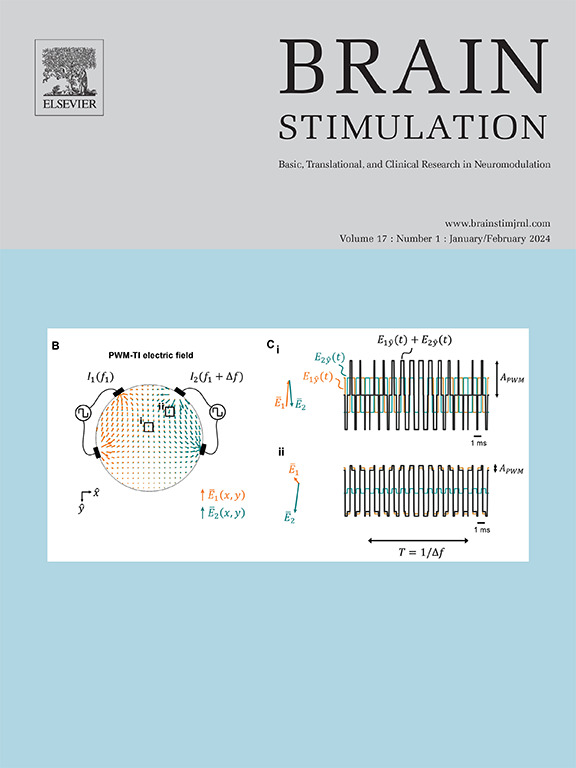The role of white matter variability in TMS neuromodulatory effects
IF 7.6
1区 医学
Q1 CLINICAL NEUROLOGY
引用次数: 0
Abstract
Background
Transcranial Magnetic Stimulation (TMS) is a widely used tool to explore the causal role of focal brain regions in cognitive processing. TMS effects over attentional processes are consistent and replicable, while at the same time subjected to individual variability. This individual variability needs to be understood to better comprehend TMS effects, and most importantly, its clinical applications.
Objective
This study aimed to explore the role of white matter variability in TMS neuromodulatory effects on behavior in healthy participants (N = 50).
Methods
Participants completed an attentional task in which orienting and alerting cues preceded near-threshold targets. Continuous Theta Burst Stimulation (cTBS) was applied over the left frontal eye field (FEF) or an active vertex condition. White matter was explored with diffusion-weighted imaging tractography and Tract-Based Spatial Statistics (TBSS).
Results
Behaviorally, TMS over the left FEF slowed down reaction times (especially in the alerting task), impaired accuracy in the objective task, and reduced the proportion of seen targets (as compared to the vertex condition). Attentional effects increased, overall, when TMS was applied to the left FEF as compared to the vertex condition. Correlations between white matter and TMS effects showed i) reduced TMS effects associated with the microstructural properties of long-range white matter pathways such as the superior longitudinal fasciculus (SLF), and interhemispheric fibers of the corpus callosum (CC), and ii) increased TMS effects in participants with high integrity of the CC connecting the stimulated region with the opposite hemisphere. Additionally, variability in attentional effects was also related to white matter, showing iii) increased alerting effects in participants with low integrity of association, commissural, and projection fibers, and iv) increased orienting effects in participants with high integrity of the right SLF III.
Conclusion
All these observations highlight the importance of taking into account individual variability in white matter for the understanding of cognitive processing and brain neuromodulation effects.
白质变异性在 TMS 神经调节效应中的作用
背景:经颅磁刺激(TMS经颅磁刺激(TMS)是一种广泛使用的工具,用于探索大脑焦点区域在认知处理过程中的因果作用。TMS 对注意力过程的影响具有一致性和可复制性,但同时也存在个体差异。要更好地理解 TMS 的效果,最重要的是其临床应用,就必须了解这种个体差异:/假设:本研究旨在探索白质变异性在 TMS 神经调节对健康参与者(50 人)行为影响中的作用:方法:参与者完成一项注意力任务,在该任务中,定向和警报提示出现在近阈值目标之前。在左额叶眼场(FEF)或活动顶点条件下施加连续 Theta 脉冲串刺激(cTBS)。通过扩散加权成像束成像和基于束的空间统计(TBSS)对白质进行了探索:从行为学角度看,对左侧FEF进行TMS刺激会减慢反应时间(尤其是在警觉任务中),影响客观任务的准确性,并降低所见目标的比例(与顶点条件相比)。与顶点条件相比,当对左侧前脑叶施加 TMS 时,注意力效应总体上有所增加。白质与TMS效应之间的相关性显示:i)与长程白质通路(如上纵筋束(SLF)和胼胝体(CC)半球间纤维)的微观结构特性相关的TMS效应降低;ii)连接受刺激区域与对侧半球的CC完整性高的参与者的TMS效应增加。此外,注意效应的变异性也与白质有关,显示iii)联想纤维、神经丛纤维和投射纤维完整性低的参与者的警觉效应增加;iv)右侧SLF III完整性高的参与者的定向效应增加:所有这些观察结果都突出表明,考虑白质的个体差异对于理解认知处理和大脑神经调节效应非常重要。
本文章由计算机程序翻译,如有差异,请以英文原文为准。
求助全文
约1分钟内获得全文
求助全文
来源期刊

Brain Stimulation
医学-临床神经学
CiteScore
13.10
自引率
9.10%
发文量
256
审稿时长
72 days
期刊介绍:
Brain Stimulation publishes on the entire field of brain stimulation, including noninvasive and invasive techniques and technologies that alter brain function through the use of electrical, magnetic, radiowave, or focally targeted pharmacologic stimulation.
Brain Stimulation aims to be the premier journal for publication of original research in the field of neuromodulation. The journal includes: a) Original articles; b) Short Communications; c) Invited and original reviews; d) Technology and methodological perspectives (reviews of new devices, description of new methods, etc.); and e) Letters to the Editor. Special issues of the journal will be considered based on scientific merit.
 求助内容:
求助内容: 应助结果提醒方式:
应助结果提醒方式:


